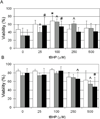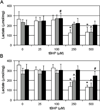Oxidant conditioning protects cartilage from mechanically induced damage
- PMID: 20058262
- PMCID: PMC3708667
- DOI: 10.1002/jor.21072
Oxidant conditioning protects cartilage from mechanically induced damage
Abstract
Articular cartilage degeneration in osteoarthritis has been linked to abnormal mechanical stresses that are known to cause chondrocyte apoptosis and metabolic derangement in in vitro models. Evidence implicating oxidative damage as the immediate cause of these harmful effects suggests that the antioxidant defenses of chondrocytes might influence their tolerance for mechanical injury. Based on evidence that antioxidant defenses in many cell types are stimulated by moderate oxidant exposure, we hypothesized that oxidant preconditioning would reduce acute chondrocyte death and proteoglycan depletion in cartilage explants after exposure to abnormal mechanical stresses. Porcine cartilage explants were treated every 48 h with tert-butyl hydrogen peroxide (tBHP) at nonlethal concentrations (25, 100, 250, and 500 microM) for a varying number of times (one, two, or four) prior to a bout of unconfined axial compression (5 MPa, 1 Hz, 1800 cycles). When compared with untreated controls, tBHP had significant positive effects on post-compression viability, lactate production, and proteoglycan losses. Overall, the most effective regime was 100 microM tBHP applied four times. RNA analysis revealed significant effects of 100 microM tBHP on gene expression. Catalase, hypoxia-inducible factor-1alpha (HIF-1alpha), and glyceraldehyde 6-phosphate dehydrogenase (GAPDH) were significantly increased relative to untreated controls in explants treated four times with 100 microM tBHP, a regime that also resulted in a significant decrease in matrix metalloproteinase-3 (MMP-3) expression. These findings demonstrate that repeated exposure of cartilage to sublethal concentrations of peroxide can moderate the acute effects of mechanical stress, a conclusion supported by evidence of peroxide-induced changes in gene expression that could render chondrocytes more resistant to oxidative damage.
(c) 2010 Orthopaedic Research Society. Published by Wiley Periodicals, Inc.
Figures





Similar articles
-
Effect of biomechanical stress on endogenous antioxidant networks in bovine articular cartilage.J Orthop Res. 2018 Feb;36(2):760-769. doi: 10.1002/jor.23728. Epub 2017 Oct 17. J Orthop Res. 2018. PMID: 28892196 Free PMC article.
-
Catabolic stress induces expression of hypoxia-inducible factor (HIF)-1 alpha in articular chondrocytes: involvement of HIF-1 alpha in the pathogenesis of osteoarthritis.Arthritis Res Ther. 2005;7(4):R904-14. doi: 10.1186/ar1765. Epub 2005 May 27. Arthritis Res Ther. 2005. PMID: 15987493 Free PMC article.
-
Antioxidants block cyclic loading induced chondrocyte death.Iowa Orthop J. 2007;27:1-8. Iowa Orthop J. 2007. PMID: 17907423 Free PMC article.
-
Role of HIF-1α and HIF-2α in osteoarthritis.Joint Bone Spine. 2015 May;82(3):144-7. doi: 10.1016/j.jbspin.2014.10.003. Epub 2014 Dec 29. Joint Bone Spine. 2015. PMID: 25553838 Review.
-
Post-traumatic osteoarthritis: the role of accelerated chondrocyte senescence.Biorheology. 2004;41(3-4):479-91. Biorheology. 2004. PMID: 15299279 Review.
Cited by
-
Dysregulated bioenergetics: a key regulator of joint inflammation.Ann Rheum Dis. 2016 Dec;75(12):2192-2200. doi: 10.1136/annrheumdis-2015-208476. Epub 2016 Mar 24. Ann Rheum Dis. 2016. PMID: 27013493 Free PMC article.
-
Genipin crosslinking decreases the mechanical wear and biochemical degradation of impacted cartilage in vitro.J Orthop Res. 2017 Mar;35(3):558-565. doi: 10.1002/jor.23411. Epub 2016 Sep 19. J Orthop Res. 2017. PMID: 27584857 Free PMC article.
-
Mechanical stress and ATP synthesis are coupled by mitochondrial oxidants in articular cartilage.J Orthop Res. 2013 Feb;31(2):191-6. doi: 10.1002/jor.22223. Epub 2012 Aug 28. J Orthop Res. 2013. PMID: 22930474 Free PMC article.
-
Strain-dependent oxidant release in articular cartilage originates from mitochondria.Biomech Model Mechanobiol. 2014 Jun;13(3):565-72. doi: 10.1007/s10237-013-0518-8. Epub 2013 Jul 30. Biomech Model Mechanobiol. 2014. PMID: 23896937 Free PMC article.
-
The role of mechanical forces in the initiation and progression of osteoarthritis.HSS J. 2012 Feb;8(1):37-8. doi: 10.1007/s11420-011-9251-y. Epub 2012 Feb 14. HSS J. 2012. PMID: 23372526 Free PMC article. No abstract available.
References
-
- Eckstein F, Faber S, Muhlbauer R, et al. Functional adaptation of human joints to mechanical stimuli. Osteoarthritis Cartilage. 2002;10:44–50. - PubMed
-
- Yao JQ, Seedhom BB. Mechanical conditioning of articular cartilage to prevalent stresses. Br J Rheumatol. 1993;32:956–965. - PubMed
-
- Hering TM. Regulation of chondrocyte gene expression. Front Biosci. 1999;4:D743–D761. - PubMed
Publication types
MeSH terms
Substances
Grants and funding
LinkOut - more resources
Full Text Sources
Medical
Research Materials
Miscellaneous

